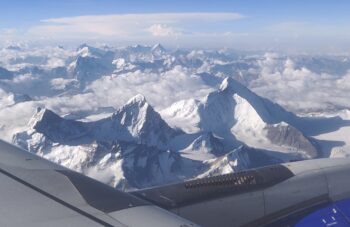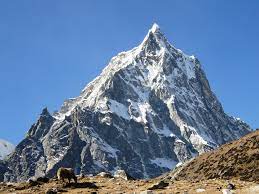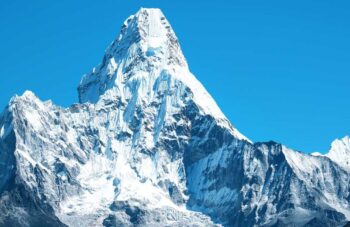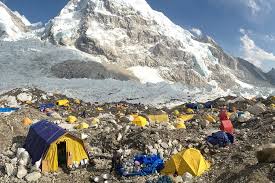The Climbing Group
For the Island Peak Climbing trip, there will be one climbing and trekking leader, assistant leader (4 trekkers: 1 assistant guide), Sherpa porters for luggage carrying (2 trekkers: 1 porter) and other helpers as per requirement in climbing section. This arrangement ensures that should anybody in the group is sick, the trip can still go ahead as planned. We can run the Island Peak Climbing trip for at least a group of two, and include maximum of twelve people only, as we’ve found this to be the optimum size for a successful trip. However, if you’d like to make a group booking for more than twelve people together, we can arrange this too.
Health & Experience Required
Island Peak is not a technical peak but you need good stamina for a long day effort while climbing it. You can climb Island peak without any previous climbing experience and skills of using climbing equipment but knowledge on using equipment and previous experience would be beneficial although not mandatory because a pre-ice climbing training is provided to you in Base Camp to make you skillful on using climbing gears such as ropes, ice pick, harness, crampons. Island Peak climbing usually requires normally 5-6 hours of walking everyday and some days even 8-10 hours- such as in summiting day. We suggest you to get prepared with about 12 Km of walking or jogging exercise every day before 3 months of your Island Peak trip because on choosing Island Peak trip, you are considering to walk in high altitude and remote area for many days and more than five hours most of the days. To join the Island Peak climbing trip with a good chance of success, you must have: Lots of willpower, ability to tolerate harsh conditions, reasonable fitness and stamina with sound health. It is vital that participants with pre-existing medical problems or conditions make these known to Everest Expeditions Nepal at the time of booking. Medical and evacuation expenses are the responsibility of the participant. It is also important that you consult your doctor for vaccination and other medical requirements for your trip. Friendship World Treks reserves the right to require a medical certificate prior to booking your trip.
A Typical day in Trekking and climbing…
Soon after first light your Sherpa wakes you up and offers you a cup of warm tea with a smile. After freshening and finishing up your tea, you will have hearty breakfast before setting off. After approximately 3 or more hours of trekking you take a break for lunch in a teahouse in the trail. Throughout the day, you will take frequent rest breaks and take time to admire and take pictures of the fascinating scenery. After a relaxing lunch, you typically spend around 2-3 hours or even more sometimes on the trail before reaching your teahouse/lodge. Once you arrive at your teahouse, you take a brief rest, shower, and have a light snack with tea or coffee. If you are so inclined, you may take a short walk through the village and surrounding neighborhood. After checking into your room you have time to read or chat with fellow trekkers and your Friendship world Treks crew. Following a warm dinner in a cozy dining hall your trek leader briefs you on the next day`s itinerary. You place your order for breakfast which allows your guide to have everything ready for you for the next morning. Extra time can be spent reading, enjoying some drinks or playing cards. Your Friendship world Treks crew loves to teach various Nepali card games as well as learning new Western games. Finally, it`s off to bed for a well earned night`s rest before starting all over again the next day.
Your schedule of climbing day (esp., summit day) is different than other days. Your crew will wake up around 1 am to prepare. They prepare breakfast and pack some food for lunch. You also should wake up around 2-3 am and will have an early breakfast. After packing and putting on the gears, you set on for the journey to summit. After summiting, you get back to your camp where the cook and helpers prepare food for you. You will find the food more delicious today after the toughest day of your adventure. You get back to sleep very tranquilly as you strike goal of your adventure today.
Travel Insurance
It is a condition of joining any of our trips that be protected against comprehensive expenses potential to incur due to medical issues or accidents (to include air ambulance, helicopter rescue, and treatment costs). Please be noted that we don’t arrange or sell insurance.
Accommodations
Accommodations are included in the trip cost and Friendship World Treks has chosen the best deluxe accommodation for 3 nights in Kathmandu in a 3/4-star Hotel According to your Budget and 12/13 nights in standard teahouse/lodge, and two/three nights in two-men camping tent. We provide attached rooms in major towns like Namche, Lukla, however teahouses/lodges in most of the places only have shared washing and toilet facilities. To sleep in tent, 4 season sleeping bag and foam mattress will be provided. We maintain standard comfort in every matter based on the enforceable conditions such as weather calamities. In climbing section, toilet facilities will be provided with necessary natural preservation. If you are a solo traveler, you will share a room/tent with someone else of same sex of your group. If you prefer a single room, you may indicate your preference and get single rooms on request by paying single supplement USD 350. However, we like you to understand the fact that there are several places that do not allow single room accommodation. On paying single supplement, you will get single room in Kathmandu but sometimes it is feasible only up to Namche Bazaar only during the trek. Above Namchhe Bazzar single accommodation is not always feasible. However, we will try our best to provide you with single rooms in all places as much as possible.
Meals
During your Island Peak expedition trip, you can enjoy typical Nepali food, different ethnic cuisines as well as all types of international cuisine (Tibetan, Continental, Italian, Indian, etc.) from pizza and Chips to apple pie. You can even enjoy hot chocolates, variety of breads, variety of drinks, and snacks. Breakfast of a day will be provided from the teahouse/lodge menu where you spent your night. Lunch will be served on the way to destination, dinner and breakfast in the teahouse/lodge where you will spend the night. During climbing session, a freshly cooked hygienic food or a packed food (as per condition) will be provided. A welcome dinner, a farewell dinner and breakfasts will be provided during your stay in Kathmandu.
Acclimatization
Our Island Peak climbing with Everest Base camp trek itinerary is planned with a high degree of awareness of AMS (Acute Mountain Sickness). Going up too fast causes a medical condition serious enough to kill. The higher the altitude the less oxygen there is in the air. For example, on the high camp & at summit, there is 50% less oxygen than at sea level. Your body needs many days to adapt to this less-oxygen environment. Our itineraries generally allow sufficient time to acclimatize. So for a safe trek and climb, it is absolutely essential to allow sufficient time for acclimatization. Sensible planning is therefore required to minimize the risk of AMS. We advise specially the guest(s) with known heart, lungs or blood diseases to consult their doctor before traveling. Mild headaches, fever, loss of appetite or stomach disorder are symptoms of AMS. Check out “Altitude illness” by Dr Jim Duff Friendship World Trekking itineraries are designed to try to prevent AMS as much as possible, but it is important to remember that some people are more vulnerable than others.
Leader(s) & Staff Arrangements
The most significant thing that makes your Island peak climbing with Everest Base Camp Trek trip successful, enjoyable and memorable is the skilled, experienced, courteous and helpful trek and climb leader and the crew members who have ability of operating your days in the mountain smoothly. Your trip will be led by the best and most professional leaders. All of our trekking/climbing leaders are carefully selected on the basis of their appropriate experience, leadership skills and personal aptitude. With an objective of sustaining local communities Friendship World Trekking employs Nepalese staffs who have adequate knowledgeable about culture, ecosystem, flora, fauna, geography, and history of Nepal. Trek/climb leaders of Friendship world Treks are also trained with following trainings to make them educated on potential medical issues during their trek, biodiversity and environmental issues, English language, etc:
• Intensive Wilderness First Aid – KEEP (Kathmandu Environmental Educational Project)
• Trekking Guide Training – Nepal Government’s Ministry of Tourism & Civil Aviation department of Hotel Management and Tourism Training Centre of Nepal.
• Eco Trekking Workshop & Adventure Meet – TAAN (Trekking Agents Association Of Nepal)
• English Language – KEEP
• Conservation and Biodiversity – KEEP
• Rock climbing, Ice Climbing and Mountaineering – Nepal Mountaineering Association
Our Trekking and climbing Leaders obviously speak English sufficient enough to communicate but please consider this is not our mother language. The guides and porters know the routes and locality like the back of their hand, they practice the local culture themselves and they are extremely passionate about their country and its cultural aspects.
Porter Care:
Though often overlooked, it’s no exaggeration to say the entire trekking and expedition industry in Nepal is built on the back of hard working local porters. It is their tireless efforts carrying supplies, equipment and baggage that make journeying to these remote areas possible. So it’s very unfortunate that they have endured a history of exploitation and abuse at the hands of the industry. In an effort to combat this, we are firmly committed to porter rights. We ensure all our porters are well treated, well paid and we provide the level of shelter, clothing and footwear that these harsh environments demand. Porters who become sick are treated with the same care and attention as other team members and we have previously used helicopters – at our expense – to rescue porters from dangerous situations. We support the work of the International Porter Protection Group (IPPG), making our resources available to them to help improve the working conditions of the porters. (International Porters Progress Group)
Responsible Tourism Practice:
Himalayan Region of Nepal is stunningly beautiful, but equally fragile. Future generations have just as much of right to appreciate it as we do. So, the tourism industry has an obligation to protect and preserve it. We employ a ‘zero impact’ policy on the natural environment.
Best Season
Best Time for Island Peak Climbing
the best months for Island Peak Climbing trip with Everest Base Camp Trek are Spring (Mid March to May) and Autumn (mid September to November) although Island peak can be climbed during the months of December, January and February
NOTE: During the trip; weather, local politics, transport or a multitude of other factors that are beyond our control can result in a change of itinerary. It is, however, very unlikely that the itinerary would be substantially altered; if alterations are necessary the leader will decide what is the best alternative, taking into consideration the best interests of the whole group. Where a change does occur, we do everything we can to minimize its effect, but we cannot be responsible for the results of changes or delays.
Flight Delay in LUKLA
Twin Otter is the primary mode of transport from the airstrip at Lukla. This service is fairly dependable. Sometimes, flights may be cancelled due to mountain weather conditions or other technical problems. In such case, Everest Expeditions Nepal will organize the alternative available road transportation or Helicopter Flight to ensure you are on schedule for your international flight. In case if you want to Flight through Helicopter then you need to Add some amount on the same cost of the Ticket of Kathmandu to Lukla.
What makes this trip different?
Everest Expeditions Nepal works closely with and is one of the main supporters of Friendship Society Nepal, a non-political and non-profit social organization. We contribute our support to the remote village of Lura, Gorakhani, Juke, Dharapani, Loading (Solukhumbhu, Nepal) through donation, sponsorship and partnership in various projects.
Donation
Everest Expeditions Nepal donates a 10% percentage of business profits to the foundation on a yearly basis, which supports the ongoing maintenance cost required for Shree Manjushree Primary school, Note Books / Copies for the Schools a community-based school in Lura Solukhumbhu (plus few other schools in the region).
Sponsorship
One of the major activities of Friendship Society Nepal is the children sponsorship program, which is conducted with full collaboration with Friendship World Treks.
Partnership (Volunteering Program)
The Solukhumbhu Volunteer Program, devised by Everest Expeditions Nepal and Friendship Society Nepal, aims to mobilize teams of experts and interested individuals as an effective and economic measure in providing the human capital for education, health and community development in Lura village of Solukhumbhu district, western Nepal.
For more details, visit Friendship Society Nepal’s website www.friendshipsocietynepal.org










Leave a Reply